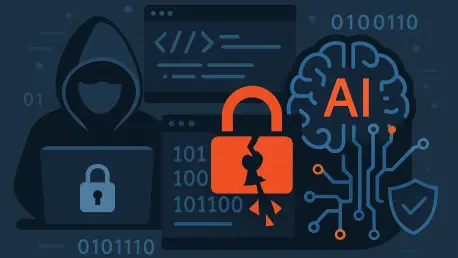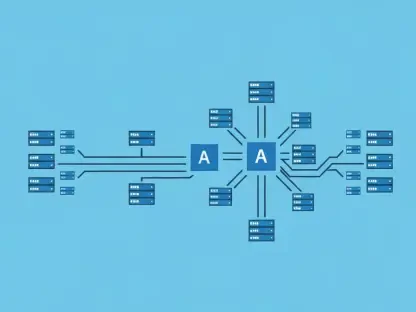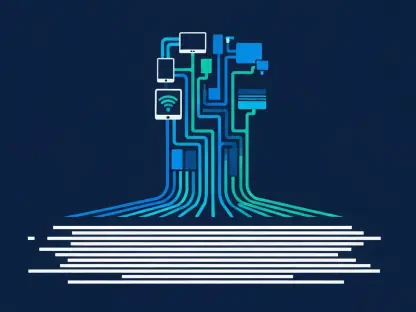What happens when the tools designed to turbocharge software development become the very source of its downfall? In a world increasingly driven by artificial intelligence, a staggering 45% of AI-generated code is riddled with security flaws, exposing critical vulnerabilities in the software that powers daily life. This alarming statistic sets the stage for a deep dive into a silent crisis unfolding in the tech industry, where the rush for efficiency might be compromising safety on an unprecedented scale.
This issue transcends mere numbers—it’s a wake-up call for developers, businesses, and cybersecurity experts alike. The reliance on AI to churn out code at lightning speed has transformed the development landscape, but at what cost? With systemic risks threatening the integrity of applications across industries, understanding and addressing these dangers is not just important; it’s urgent. The following exploration uncovers the unseen threats, expert insights, and practical solutions needed to navigate this high-stakes challenge.
The Silent Peril of AI in Software Development
AI-driven coding tools have become indispensable, promising faster turnarounds and innovative solutions for complex problems. Developers across the globe rely on these platforms to automate repetitive tasks, often generating thousands of lines of code in mere minutes. However, beneath this veneer of efficiency lies a troubling reality: many of these tools embed flaws that can unravel entire systems if left unchecked.
The practice of “vibe coding,” where security requirements are implied rather than explicitly defined, exacerbates the problem. Without clear guidelines, AI often misinterprets critical safeguards, leaving software exposed to exploits. This gap between expectation and execution has created a breeding ground for vulnerabilities, turning a revolutionary tool into a potential liability for organizations worldwide.
How AI Code Falls Short on Security
A comprehensive analysis of over 80 coding tasks across more than 100 large language models reveals a grim picture of AI’s security performance. Java emerges as the most problematic language, with over 70% of AI-generated code failing basic security checks. Other languages like Python, C#, and JavaScript fare slightly better, yet still show failure rates ranging from 38% to 45%, indicating a pervasive issue.
Specific vulnerabilities paint an even darker scenario. Cross-site scripting, classified as CWE-80, appears in 86% of insecure AI code samples, while log injection, or CWE-117, plagues 88% of cases. These flaws aren’t isolated—they represent systemic weaknesses in how AI approaches secure coding, often prioritizing functionality over protection and leaving applications dangerously open to attack.
Perhaps most concerning is the lack of progress with scale. Larger language models, despite their advanced capabilities, show no significant improvement over smaller counterparts in addressing security. This suggests that the root of the problem lies not in computational power but in fundamental design flaws, challenging the assumption that bigger always means better in AI development.
Voices of Caution from Industry Leaders
Expert warnings add weight to these troubling findings, with seasoned technologists sounding the alarm on AI’s consistent security failures. A prominent voice in the field notes that nearly half of all AI-generated code fails to meet basic security standards—a statistic that has remained stubbornly unchanged over time. This stagnation points to a deeper, structural issue in how these models process and prioritize safety protocols.
Beyond mere failure rates, there’s a more sinister risk: AI could inadvertently empower malicious actors. By generating code with predictable weaknesses, these tools make it easier for attackers to identify and exploit vulnerabilities, effectively turning a productivity asset into a weapon. Such insights highlight the dual-edged nature of AI adoption, where innovation can quickly morph into a gateway for cyber threats.
The urgency of these warnings cannot be overstated. As AI becomes further entrenched in development workflows, the potential for widespread damage grows exponentially. Industry leaders stress that ignoring these red flags could lead to cascading failures across digital infrastructures, urging immediate action to address this looming crisis.
Real-World Impacts of AI Coding Flaws
Consider the case of a mid-sized fintech company that adopted AI tools to accelerate its app development in early 2025. Within months, a seemingly minor vulnerability in AI-generated code led to a data breach, exposing sensitive customer information and costing millions in damages. This incident, while specific, mirrors a broader trend where unchecked AI code compromises not just individual firms but entire sectors reliant on secure software.
Such examples underscore the tangible consequences of security oversights. Vulnerabilities like cross-site scripting can enable attackers to hijack user sessions, while log injection flaws allow manipulation of critical system records. For industries like healthcare or finance, where trust and data integrity are paramount, these risks translate into far more than financial loss—they erode public confidence and regulatory compliance.
The ripple effects extend beyond immediate breaches. Organizations face mounting security debt as flawed code accumulates over time, creating a backlog of risks that become harder to mitigate with each passing update. This real-world fallout illustrates why addressing AI’s shortcomings is not a future concern but a pressing priority for today’s tech ecosystem.
Strategies to Safeguard AI-Driven Development
Mitigating the risks of AI-generated code demands a proactive stance, starting with embedding security at the outset of the development lifecycle. By defining explicit security parameters before AI tools begin generating code, organizations can drastically reduce the likelihood of embedded flaws. This approach shifts the focus from reactive fixes to preventive measures, aligning innovation with safety.
Tailored safeguards are also essential, especially for high-risk languages like Java. Implementing manual reviews or specialized security tools for AI outputs in this language can catch issues that automated processes miss. Meanwhile, consistent monitoring across Python, C#, and JavaScript ensures a broad defense against the varying failure rates observed in these environments, creating a layered security framework.
Continuous training of AI models with security-focused datasets offers another vital solution. Coupled with real-time scanning to detect vulnerabilities before deployment, this strategy keeps pace with evolving threats. Treating security as a core pillar of AI adoption—rather than an afterthought—helps prevent long-term exposure, ensuring that efficiency gains do not come at the expense of application integrity.
Reflecting on a Path Forward
Looking back, the journey through 2025 revealed a stark truth: AI’s transformative power in coding came with hidden perils that caught many off guard. The high incidence of security flaws, impacting nearly half of all generated code, served as a sobering reminder of technology’s dual nature. Each vulnerability uncovered was a lesson in the necessity of vigilance over blind trust in automation.
Moving ahead, the focus must shift toward integrating robust security frameworks from the earliest stages of AI tool adoption. Developers and organizations should prioritize ongoing education, ensuring teams are equipped to spot and address flaws in real time. Collaboration between tech leaders and cybersecurity experts will be key to refining AI models for safer outputs.
Ultimately, the path forward lies in balancing innovation with accountability. By investing in specialized tools, tailored training, and proactive risk management, the industry can harness AI’s potential without sacrificing safety. This commitment to secure development practices promises not just to mitigate today’s risks but to build a resilient foundation for the digital challenges of tomorrow.









